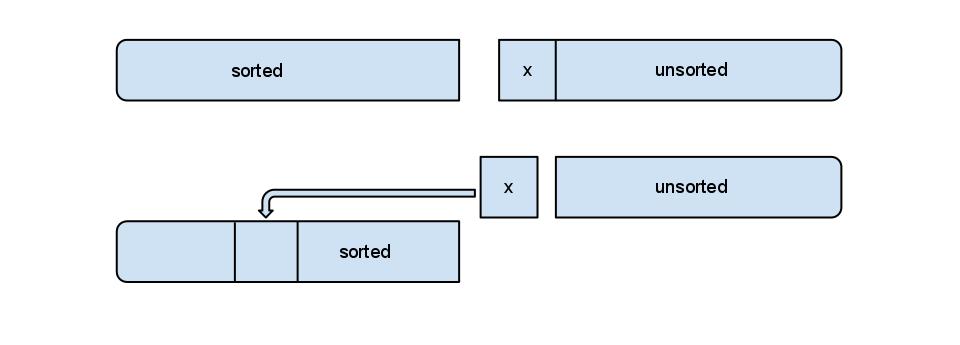Click on the image to download this cheatsheet on PDF!

It’s weird that bubble sort is the most famous sorting algorithm in practice since it is one of the worst approaches for data sorting. Why is bubble sort so famous? Perhaps because of its exotic name or because it is so easy to implement. First let’s take a look on its nature.
Bubble sort consists of comparing each pair of adjacent items. Then one of those two items is considered smaller (lighter) and if the lighter element is on the right side of its neighbour, they swap places. Thus the lightest element bubbles to the surface and at the end of each iteration it appears on the top. I’ll try to explain this simple principle with some pictures.

Here “2” appears to be less than “4”, so it is considered lighter and it continues to bubble to the surface (the front of the array).
Continue reading Computer Algorithms: Bubble Sort
Sorted data can dramatically change the speed of our program, therefore sorting algorithms are something quite special in computer science. For instance searching in a sorted list is faster than searching in an unordered list.
There are two main approaches in sorting – by comparing the elements and without comparing them. A typical algorithm from the first group is insertion sort. This algorithm is very simple and very intuitive to implement, but unfortunately it is not so effective compared to other sorting algorithms as quicksort and merge sort. Indeed insertion sort is useful for small sets of data with no more than about 20 items.
Insertion sort it is very intuitive method of sorting items and we often use it when we play card games. In this case the player often gets an unordered set of playing cards and intuitively starts to sort it. First by taking a card, making some comparisons and then putting the card on the right position.
So let’s say we have an array of data. In the first step the array is unordered, but we can say that it consists of two sub-sets: sorted and unordered, where on the first step the only item in the sorted sub-set is its first item. If the length of the array is n the algorithm is considered completed in n-1 steps. On each step our sorted subset is growing with one item. The thing is that we take the first item from the unordered sub-set and with some comparisons we put it into its place in the sorted sub-set, like on the diagram bellow.

Continue reading Computer Algorithms: Insertion Sort
Yes! It’s really really fast, and it’s far quicker than the quicksort algorithm, which is considered as the fastest sorting algorithm in practice. However how it’s possible to be faster than the quicksort, which is the fastest algorithm?! Is that true? Actually it’s true, but only in few cases. It works with integers, you’ve to know the first and the last element from that set and you’ve to be sure that every element is unique
Imagine you’ve a set of numbers all of them greater than 1 and lesser than 1000. Of course you’re not suppose to have all of the integers between 1 and 1000, but only few of them – think of 500 numbers between 1 and 1000! Here’s important to note – that this is only an example, you can have far more than only few numbers between 1 and 1000 – what about the numbers between 1 and 1,000,000 – this is a big set, isn’t it.
The question is – if there are so many constraints, why should I use that algorithm instead of quicksort, or another sorting algorithm, that works with everything. The answer is clear – yes, you’d prefer quicksort if you’ve to sort some arbitrary data, but when it comes to integers, and you’ve, let’s say, 1,000,000 integers, my advice is – use this algorithm!
First we have an unsorted array, but we know the minimum and maximum of the set.
On the first pass initialize an empty array with as many elements, as they are between the first and the last element of the set – for a set between 1 and 1000 – that will be an array with 1000 elements – each of which will be a zero in the beginning.
Than loop trough the set and for every element in the set – you should put a 1 on it’s place
Now we have an array of 0 and 1.
After the first pass, you’d guess what you’ve to do – loop trough the second array and print the keys of the elements different from 0 – those that are 1.
Now the array is sorted!
var a = [34, 203, 3, 746, 200, 984, 198, 764]; function setSort(arr) { var t = [], len = arr.length; for (var i = 0; i < 1000; i++) { t[i] = 0; } for (i = 0; i < len; i++) { t[arr[i]] = 1; } for (i = 0; i < 1000; i++) { if (1 == t[i]) { console.log(i); } } } setSort(a); |
Now that you’ve seen that algorithm, perhaps you’d guess that it’s no so difficult to change from integers to any other set, and once again I should say that in many cases this is the best algorithm for sorting! Very often quicksort is preferred, but not always there isn’t something faster!